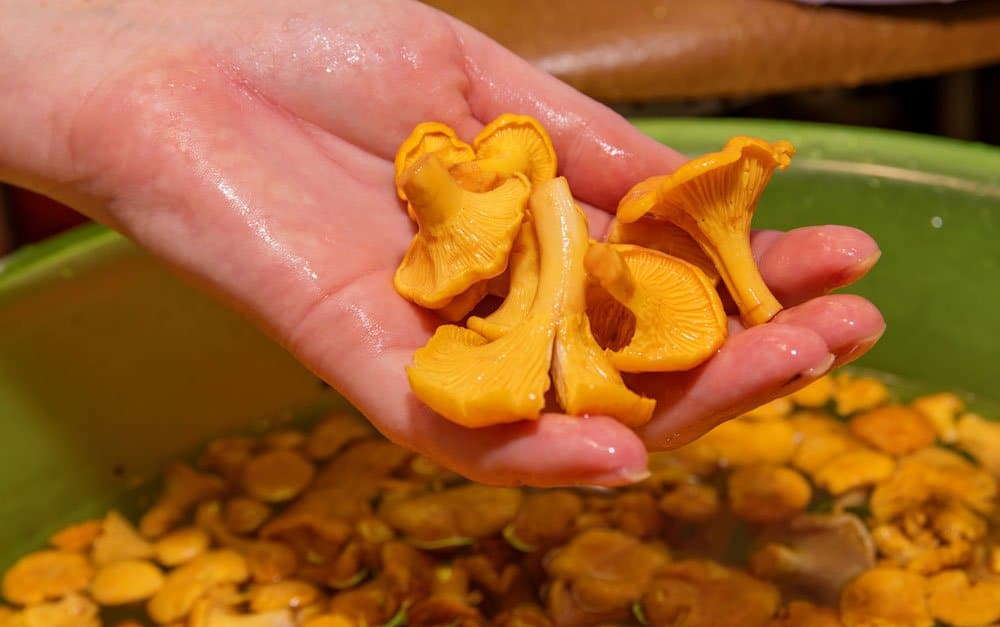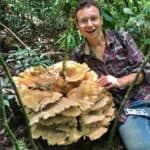Table of Contents
After a long day of picking mushrooms, most of us just want to eat a good meal and relax. While just throwing your fresh-picked shrooms’ in the fridge is tempting, you know there’s one thing left to do…
Cleaning your Mushrooms! Is it just me that finds it tedious?
Well, through experience I’ve kinda got the hang of the routine. Also, I’ve figured out the easiest and most effective way to do it. Ultimately, it’s not THAT bad.
Why clean your Mushrooms?
- So you don’t end up with pine needles, dirt, or other gunk in your meal!
- It also helps with storage. Clean mushrooms tend to last much longer.
- They’ll also be easy and convenient to cook whenever you need them!
My #1 Secret to cleaning your Mushrooms
If you’re new to the mushroom picking scene, let me share with you a little secret. This makes the whole process simpler.
Don’t Dirty Your Mushrooms While Picking!
I’ll be sincere, some mushrooms are dirty. Most though, are clean when you pick them. They get dirty in your basket/bag during transportation. When you place one dirty mushroom in your basket/bag, it gets the rest of them dirtier!
Tips to prevent your Mushrooms from getting dirty while picking
- Cut The Stems to Harvest – The stem butt is the bottom of the mushroom attached to the ground. I recommend cutting the stem butt when harvesting. This is better than actually “picking” the mushroom. This removes the dirtiest part of the mushroom.
- Preliminary Cleaning – While it’s tempting to throw your mushrooms directly in your basket/bag, it’s best to do a quick clean first. Lots of the dirt/leaves are only loosely on your mushroom and can be easily brushed off. Otherwise, they will get other mushrooms dirty or the dirt may get worked into the tissues.
- Use a Wide Basket – Using a wide basket is the BEST option for mushroom picking. It prevents you from putting too many mushrooms on top of each other. This prevents them from becoming dirtier and becoming damaged by their weight. The porosity of the basket also allows spores to spread through the forest while you walk!
- Bring Wax Paper or Bags – You can wrap small or brittle mushrooms to prevent them from becoming damaged. Otherwise, they can become a gazillion pieces by the time you’re done with the hunt. You can also use it to wrap filthy mushrooms, like the famous “California Mud Puppies”.
- Be Picky! – There’s no point in picking old, damaged, or filthy mushrooms. These end up breaking apart and making more work for you in the long run.
Washing with or without Water?
Most people will tell you to avoid wetting your mushrooms when cleaning. This can get your mushrooms soggy and thus diminish their quality. After all, soggy mushrooms don’t have a nice texture or flavor.
But…
If you have time to let them air dry for a while it’s OKAY to get them wet. Place them on a piece of cardboard or a breathable rack. You know they are ready when they become rubbery and have lost excessive moisture.
Many pickers with LARGE hauls will even hose them down for the quickest results!
How to clean Morel Mushrooms
Morels have a strange texture that can be a challenge to clean. Their hollow inside can also host a lot of bugs and dirt. Thankfully, there is an easy way to clean them up!
- Dunk and shake them in water. If there is a lot of gunk in their hollow insides, cut them in half first.
- Place them on a piece of cardboard to air dry for 15-30 minutes.
- Cook them immediately or store them in a cardboard box inside the fridge.
How to clean Portobello Mushrooms
Portobellos can easily become saturated with water. For this reason, avoid wetting them excessively right before cooking.
- Cut off dirty stem butts if present.
- Wash them by rubbing a moist towel across their surface to remove any dirt.
- Cook immediately or store in the fridge.
How to clean Oyster Mushrooms
Oysters are usually pretty clean since they don’t grow directly from the ground. Regardless sometimes you will need to clean them before cooking.
- Cut off stem butts with any signs of organic material.
- Wild oysters often have a lot of maggots so discard any that are soft, brittle, or display any other symptoms of age.
- Use a moist paper towel to remove excess dirt.
- Some insects live in the mushroom gills. Remove these with a brush or by blowing between the gills profusely.
- Cook immediately or store in the fridge.
How to clean Shiitake Mushrooms
Shiitake mushrooms rarely need cleaning, but if they do it’s quick.
- Cut off the woody stem.
- Use a moist towel to rub off any external dirt.
- Cook immediately or store in the fridge.
How to clean Baby Bella Mushrooms
Follow the instructions mentioned above for portobello mushrooms.
How to clean Chanterelle Mushrooms
Chanterelles are some of the most widely foraged mushrooms. While they are usually clean, some varieties do get particularly muddy.
- Discard any questionable mushrooms or those with evidence of maggots.
- With a knife, cut or scrape any damaged or undesirable parts of the mushrooms. This includes anything mushy or oxidized.
- Use a moist towel to wash off any dirt or organic materials.
- Alternatively, wash them under a sink. Afterward, let them dry for 12-24 hours before cooking or storing them in the fridge.
How to clean Lobster Mushrooms
Lobster mushrooms can be a bit tricky to clean because they have a crinkly uneven texture. Because of this they often hold dirt that is not straightforward to remove.
- Lobster mushrooms should be firm. Discard any parts of the mushrooms that are spongy.
- Using a knife scrape off the outer parts encrusted with dirt.
- If necessary, place under running water. Avoid submerging them for extended periods.
- Cook immediately or store in the fridge.

